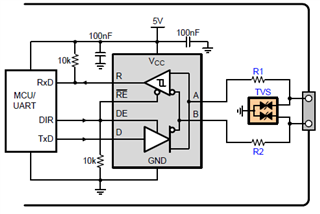Other Parts Discussed in Thread: SN65HVD73, THVD1410
Hi,
We are using RS485 SN65HVD70, My doubt is, when the Termination resistor(Rt) and Bias resistor's are mandatory or optional ?
We read document TIA/EIA-485 (RS-485), SLLA036D and https://e2e.ti.com/blogs_/b/analogwire/posts/rs-485-basics-when-termination-is-necessary-and-how-to-do-it-properly.
But still having some doubt on the calculation.
1. If, 2tpd > tt/5, we need to use Rt and if 2tpd < tt/5, no need to use Rt right?
2. How to find propagation time tpd?
3. unit interval (UI) mean (T=1/F) and F is Transmit date speed that is baud rate right? If buad rate is 9600 bit/sec, UI=1/9600=0.000104 right?
4. Finally, unable to relate with equation 2tpd > tt/5. Kindly advise how to calculate tpd and tt with giving one example. We use buad rate= 9600 bit/sec and cable length 100meter.
Thanks and regards,
Naveen K

Thanks and regards,
Naveen K





